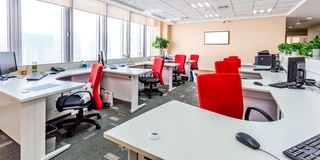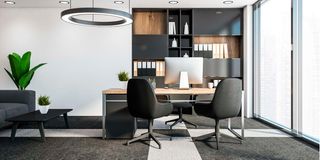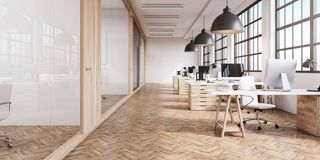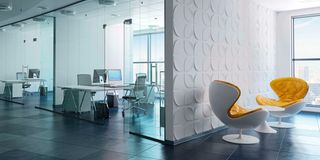Premium
Revamp your workspace to boost your employees’ productivity

Beyond the layout, there are many simple and complex changes that could breathe life into your workspace.
What you need to know:
- Simply changing the colours and lighting can have a huge impact.
- A boardroom that hosts private and sensitive discussions could use some acoustics.
It is estimated that the average human being spends a third of their life at work. It is no secret that the spaces we occupy affect our productivity, mood and quality of life.
This brings us to the question, when was the last time your business or work space enjoyed a revamp?
Does it support everyday tasks efficiently, is it the kind of space people enjoy coming to everyday?
Perhaps your first thought is "with the economic situation, no one should be thinking of redesigning their workspace”, yet the truth is that revamping your business premise might actually save you money or improve your cash flows in the long run.
Who should consider a revamp?
First things first, why is a workspace revamp important? There are several reasons, and one of them is wastage of precious space.
Kevin Otwoma, an interior designer at Mozza Interiors, says that in some cases, business owners assume they need a particular feature in their workspace, but as the business takes shape, some features are not fully utilised.
“For instance, an office meant for administrative work within a restaurant could end up being wasted space. If a business was to evaluate its activities, the owner would realise that some of the wasted space could be allocated to more productive activities,” explains Otwoma.
Commercial spaces could also be ineffective in a way that gives clients a bad experience. Sometimes it is the employees who struggle to stay productive within the available space. A revamp could significantly improve business processes and attract more clients in the long run.
Who, then, should be considering an urgent revamp? First on the list is any business experiencing substantial growth.
"Many businesses in Kenya start with a basic rental space which often lacks a lot," says Tracy Nyarango, an Interior Designer.
But as the business grows, its needs change. A bigger workforce, for instance, might require more space. The business might also need more storage space, and as it grows, so does its name and brand. An upgrade in its location's aesthetics would not hurt.
"Sometimes a workspace is initially designed for production or other technical purposes without considering other departments such as sales, marketing or accounting," explains Tracy.

A revamp of the workspace could significantly improve business processes and attract more clients.
As the business expands, new professionals may be forced to work in an environment that not only hinders their productivity, but may also affect their health. Think of a marketing professional working in a loud factory, with production going on in the background.
“A revamp could lead to healthier employees and improved productivity,” adds Tracy.
If a business has experienced changes in the kind of services it offers, a redesign is also necessary, especially if its traditional spaces are not in use anymore. It could be the business digitised processes or the services they offer changed.
As Tracy points out, tech is taking over, and digital needs are expanding. Server rooms for instance, were initially designed as spare, barely significant, spaces within organisations. Most of them are cold and dark.
But now, digital data is more valuable than ever and these rooms might need an upgrade. If workers are spending more time in the server rooms, Tracy points out, companies need to consider the health situation there. Simply put, if you have not evaluated your business space after all the digital migration of services and processes, now would be the right time.
Lastly, shrinking businesses too need to re-evaluate their commercial space. An entity could be renting more space than it needs even after its workforce has reduced significantly. Redesigning the space could lift the financial burden from the business, creating more room to improve cash flows.
Avoiding costly mistakes
Let's get into the process of revamping your work space. One of the most common mistakes people make is jumping right in with cosmetic upgrades, only to regret the decision shortly after.
Otwoma, above, points out that by the time you decide to revamp the business, you should know what you want to change or the pressing issues that need solutions.
“Once you have figured this out, you can consult a designer to help you visualise the change, plan the redesign and avoid some of the mistakes people make. Most mistakes revolve around the layout," Otwoma says.
"It could be as simple as the arrangement of furniture and equipment, which could affect circulation or traffic flow in the space. Wrong circulation might also lead to congestion in the case of a retail space,” he says, adding that it could also minimise the space allocated to customers or lead to issues at the checkout.

Revamping your business premise might save you money or improve your cash flows in the long run.
Another mistake is overlooking some departments and allocating them less space than what they need. For instance, in a bank, tellers traditionally occupy a lot of space, but with mobile banking, other departments could use more of that space. Proper planning with the help of an expert will help you avoid such costly mistakes.
Rather than implementing a general trend you've seen in other offices or online, scrutinise your space and ensure your needs are valid.
Some of the areas Otwoma suggests looking into include the general layout of the business space and how people interact with it.
“If the space accommodates people, I'd be looking at how to work around the lighting. I would try to introduce more natural lighting and also work on the general lighting. Different spaces require different types of lighting.
"I would also pay attention to circulation, and that might lead to the type of partitions in the space, lastly, depending on the budget, I would encourage business owners to introduce more nature within their workspaces. This could be in the form of plants, or decorative elements that imitate nature, like water features."
Get feedback
Feedback from those who use the space on a daily basis is highly important. As Tracy suggests, talking to employees can shed more light on the urgent problem areas and how to fix them.
"A revamp should be pegged on solving the big issues, however, consider what you can afford too," she advises.
"While collecting feedback, strive to understand the most crucial tasks and the employees' pressing needs. Some employees need privacy and others need to work in open spaces that encourage collaboration,” explains the interior designer.
A boardroom that hosts private and sensitive discussions could use some acoustics, for instance, but one where discussions are creative and collaborative could be more homely, cosy and not so closed.
Beyond the layout, there are many simple and complex changes that could breathe life into your space.
"A revamp does not have to involve major changes. factors like colour and lighting have a big impact on mood and productivity. You might also consider harmonising the brand identity by capturing company colours and logos within different spaces in the physical location.
Human-Centric Spaces
"Companies also need to introduce human-centric spaces within their offices. For instance, if you are operating from an inaccessible space, it means you can't employ people with disability. A lot of design changes lately revolve around making employees more comfortable at work. Businesses are introducing cosy, break out sections where people can take a break but still within the workspace, lactation spaces and kitchens," Tracy notes.
These kinds of spaces can improve employee retention as they are considered a mindful gesture. If short of money, certain features and corners can be designed to host multiple functions or adapt to change in the future.

Feedback from those who use the workspace daily is highly important.
"Consider what else the space can do when the company's needs change. For instance, if you're doing a showroom, an office may not be a key demand, but you can put in moveable partitions, so that when you do not need it, changes can be made within minutes.
"Breakout rooms can still be in the kitchen, perhaps a cosy couch or chair where employees do a bit of work, eat or rest. A boardroom can also serve other purposes if designed creatively."
Safety and limitations
Tracy points out that safety has to be part of the conversation.
"The International Organization (ISO) has a set of policies and guidelines that help businesses and workspaces maintain safety. When you are designing, consider these standards and the recommended features. Safety is more important than aesthetics.
"The flooring, for instance, needs to be safe depending on the traffic and activities involved. Durability of materials is also important. If these things are not considered, replacements will cost more later," she explains.
On limitations, some rental properties set limits on the structural changes one can make. Bear this in mind too. Financial limitations and availability of materials locally could also cause problems.
To this, Tracy says, "Keep an open mind. If you cannot afford your desired changes, or if the fixtures and materials are not available in local markets, your consulting designer can suggest alternatives."
Adapting to a multi-generational workforce
Finally, one other consideration when revamping is to accommodate multiple generations within the workspace through design. According to a journal by Havard Business Review, published in 2022, employee turnover is projected to increase from 50 per cent to 75 per cent.
The journal also suggests that it is taking 18 percent longer for businesses to fill up vacant roles. With such figures, it is a difficult time for businesses, given that human resource is at the heart of entrepreneurship.
Perhaps it is time for businesses to focus more on retaining both the young and older employees. A few tweaks in the workspace can have significant impact on this. Otwoma suggests two interesting changes.
"Young professionals are growing career wise, they want more information and learning opportunities. You need to create an environment where they can access more information. It could be a library with digital resources where they learn and grow.
Socially, they start young but they grow over time. They start having children. In the near future, their needs change. If they are female, they might need space for childcare or daycare, says Otwoma.
And for the older folks, "Create spaces for retraining the older workforce to help them adapt to technology and new business processes. You could also look at their health concerns. Accessibility should be part of the revamp. If possible, inject some flexibility into the workspace, such that employees can customise their personal space in a way that works for them”.





